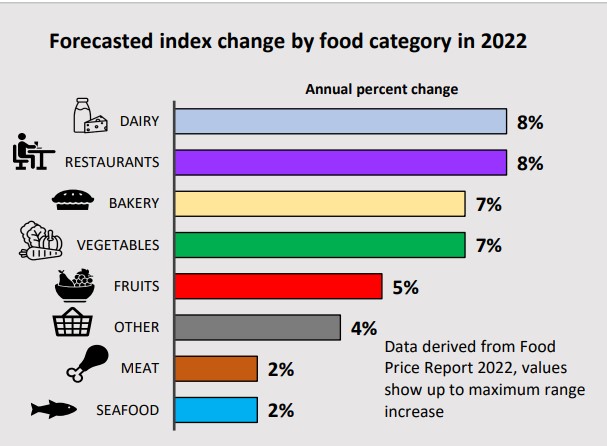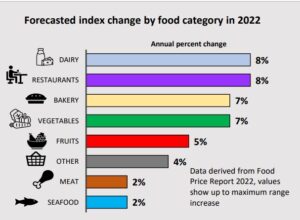The challenges of filling bellies as food prices soar
Prepping for the holidays means heading to the store to stock up on groceries. Based on provincial capacity limits, Ontario families could be entertaining up to 25 people in their homes this holiday season. With food prices on the rise, that grocery bill will be pricey. Heading into the new year, shoppers will be paying more to feed their families.
According to Canada’s Food Price Report 2022 (released December 9), an average family of four is expected to pay up to $14,767 for food in 2022. That represents an increase of about $966 from the total annual food cost in 2021, an overall increase between 5% and 7%.
Food prices in the dairy department are likely to increase as high as 8%, due in large part to the Canadian Dairy Commission’s intended 8.4% increase in farm gate milk prices next February. That increase works out to an extra six cents a litre and is intended to partially offset the rising production costs.
The authors of the Report, members from four Canadian universities, Dalhousie University, University of Guelph, University of Saskatchewan and University of British Colombia, say this is the highest increase in twelve years. Last year’s report predicted an increase of up to 5% for 2021, or $13,907 for that same family of four. In actuality, annual food expenditures totaled $13,801 for a family unit, a difference of about $106 less for that year.
Soaring inflation, driven by higher prices in fuel, housing and food further affect the purchasing power of Canadians. With restaurant menu prices expected to increase by up to 8% and a five to seven percent increase in baked goods and vegetables, Canadians may find it more challenging to budget for healthy food choices and meal management.
The continued disruption in the food supply chain, labour shortages and the growing impact of climate change may further impact the trajectory of the cost to put food on the table. This will likely feed into the greater issue of food insecurity.
Prior to the pandemic, Canada ranked 18th in the Global Food Security Index 2019 where food affordability was considered. In 2021, Canada has dropped six spots to 24th worldwide.
One of the main issues is that wages have not kept pace with the rate of inflation. Lower-income families will likely spend a higher proportion of their income on basic necessities like housing, food and transportation. Inevitably, making it more difficult to maintain their existing quality of life as costs continue to soar.
Many will find themselves turning to community food banks for support. Since the onset of the pandemic, visits to food banks across the country rose 20%. Food Banks Canada estimates that nearly one in seven food banks are experiencing a doubling of demand.
In the meantime, changing habits to buy local and only what you need may help reduce the impact on a family’s food expenditures. Finding ways to reinvent leftovers to help minimize food waste are some ways to support sustainable, healthy and ethical choices while adjusting to the rising cost of food.




